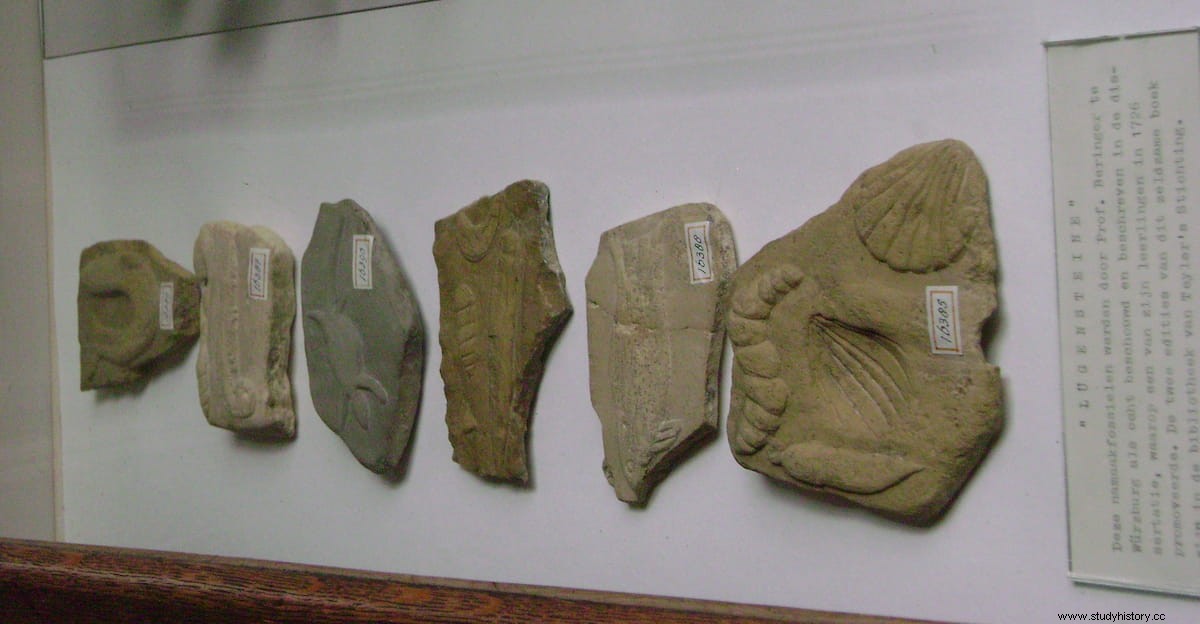Fossils prove the existence of life in its heyday, but in the case of Dr. Adam Beringer, they wrote nothing but its demise. Nearly 300 years ago, he discovered an assemblage of plant and animal fossils near Würzburg in southern Germany, marking the end of his prosperous career.
These fossils became known as Lügensteine or “Liar Stones” that provoked one of the biggest paleontological frauds in the history of the world. But what makes this hoax legendary, aside from a host of moral lessons and twists, is the fact that at the heart of the joke was a wise man with the utmost credibility (until he wasn't). /P>
Born in 1667, Dr. Johann Bartholomew Adam Beringer became an important man in 18th-century Wurzburg. He was a professor and dean of the Faculty of Medicine at the University of Würzburg and practiced medicine at the Julian Hospital. His days were spent publishing scholarly papers that were cited by scientists around the world, but all of his free time was spent by Beringer feeding his personal passion:natural history.

Although conventional in most respects, the doctor was known to own a cabinet of curiosities that had on display the most wonderful objects of the natural world. He was chief physician to the Prince Bishop of Wurzburg and Duke of Franconia at a time when modern medicine relied heavily on natural remedies, and in 1695 he was also appointed Keeper of the University's botanical gardens, in keeping with your interests and aptitudes.
But for all his accomplishments, there were many who despised the doctor's rise to fame. At the University, two of his own classmates were convinced that they would bring down Beringer, and had been hatching plans to that effect for a long time. J. Ignatz Roderick, a professor of geography and algebra, and Georg von Eckhart, a librarian, were to tap into Beringer's love of fossils from Mount Eibelstadt, which lay south of Würzburg.

All went well until the summer of 1725, when the duo planted fake fossils on the mountain for him to find. Beringer had hired three young men to unearth treasures from the earth for his beloved cabinet; it is said that at least one of them was aware of the whole plan. The excavators began handing him the apparently spectacular fossils, and Beringer was immediately spellbound. He did not know that these fossils would later be known as Lügensteine .
The fossils were perceptibly extraordinary, even to Beringer. Shell limestone rocks from the Middle Triassic are still found on the Eibelstadt land today. But these iconoliths were different. Most of them were in low relief, with the fossil fitting perfectly inside the stone to make it look handcrafted. In the fossils that showed remnants of a skeletal structure, the anatomy was obviously wrong. There were fish and frogs, birds and snails carved on these stones, but also iconoliths in the shape of angels and stones with Hebrew letters that spelled out the tetragrammaton YHVH:the name of God.
Many expressed fears about the credibility of the fossils, but Beringer was undeterred and continued to document his finds in his Lithographiae Wirceburgensis from 1726. The book contained 21 plates with 204 specimens. Although written in Latin, it was later translated into English by Melvin E. Jahn and Daniel J. Woolf.

«The figures expressed in these stones, especially those of insects, are adjusted so exactly to the dimensions of the stones, that one would swear that they are the work of a very meticulous sculptor «, He had written in his book. In his passion, he wrote the entire work without acknowledging what his own observations revealed:the fossils were fake. Only after publishing the book did he acknowledge that he had been deceived. Something had changed, but what?
Over the years, the suspense of the story has been attributed to different anecdotes. But the most popular remains that the doctor eventually found a stone with a Hebrew inscription translating his own name, and only then did he realize that the findings had been false all along. Some suggested that it was his students who played a prank on the teacher.

But after accepting his error, Beringer initiated legal proceedings against his three excavators, which allegedly implicated the professor's companions, Roderick and Eckhart. It is rumored that the once-revered scientist fell into gradual decline from that point on, buying copies of his own book and losing track of his professional career until his eventual death a few years later. The incident also affected the pranksters. While Roderick had to leave Würzburg, Eckhart was unable to finish his scholarship.
Although the stones never became as famous as Piltdown Man, they helped revive the conversation around trickery in the world of science. The incident prompted the opening of the Lügensteine Association in Germany, dedicated exclusively to fake fossils.
Of the more than 2,000 stones that Beringer discovered, some 600 were distributed throughout England, Germany, and Austria. The forgeries were exhibited at the British Museum in 1961, while casts of some of the fossils were kept at the Naturkunde Museum in Bamberg. All of them are original, and they constitute an ironic piece of counterfeiting that the world can still see today.
This article was published in Amusing Planet. Translated and republished with permission.
